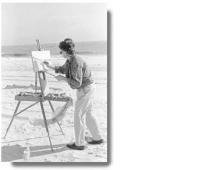Opinion: It's Never Too Late To Start

Every Friday morning since the beginning of the 1980s, the Sixty Plus Club's painting group has met at the East Hampton Town Senior Citizens Center. Last weekend it held a well-attended two-day exhibit of some of its members' achievements.
Perhaps the one quality of the show that stood out was its youthful exuberance and spontaneity. These artists seem willing to take on just about any subject or media, jumping from landscapes to portraits to still lifes, from abstraction to realism to collage. There were even two sculpture entries, from Helen Lowry and Maria Ludwig.
Wandering around Guild Hall's large gallery, there was almost too much to absorb. But there were some entries that just grabbed you by the ear and made you take a second look, like Esther Berlin's masterly collage "New York Times Review."
Flowing Collage
Ms. Berlin had a number of bright, colorful collages, but this one, with its swirling, flowing composition of decoupage, feathers, fibers, and acrylics in tones of blues and blacks with a touch of red, was full of motion but totally in control.
Jeanette Molloy had an interesting range of work, covering the spectrum from Oriental patterns to watercolors of glassware, with the provenance of each piece identified in writing.
But there was no getting away from the star of her collection, a spectacular watercolor, "Tulips," which spins outward from the center of the canvas in an explosion of red, yellow, pink, and orange blossoms against a background of intricate mauve and blue fabrics.
Bold "Barn"
Some of Barbara Bonaventura's watercolors are a little inhibited, but two are notable for their spontaneity and bold use of color: "Red Barn," with its lavish, well-controlled reds and browns, and "Charles Bridge," a nicely atmospheric sunset.
Another artist who has a good hand with color is Beverly George, whose impressionistic "Garden by the Sea," where a woman stands in long grass scattered with poppies, is the very essence of a summer afternoon.
Then there were Marj Rooney's cynical, quizzical ducks, Ms. Ludwig's and Bernice Andeus's elegant black and white landscapes, and Charles Singer's whimsical Swiss cow with a watchface hanging from its neck instead of a cowbell.
But without doubt the most interesting paintings in the show are by Elizabeth Sonnanburg, because they act as a history of the accomplishments of the artists in this group.
At first glance, you feel sure the Sonnanburg paintings must be the work of two separate people. How could that wobbly windmill with the brilliant green grass possibly be painted by the same artist as "Fall Harvest," a beautifully composed, professionally rendered still life of vegetables, or "Rhythmic Branches," a masterly rendition of leaves without a wasted brush stroke?
But then you look at the dates and realize that the less skillful works date from the early 1980s, when she must have just been starting out, while the others were painted recently.
Where artists with bigger egos would have shown only their best work, Ms. Sonnanburg has let us see every step along the road to becoming a really competent artist. Good for her!
The Joy Of Working
There was also work - some farther along the road than others, but all equally heartfelt - from Vivian Moss, Helen L. Petersen, Thelma L. Callahan, Ed Butler, and Arlene Coulter.
It was good of Guild Hall to give this group of senior citizens a platform to show their work, even if it was just for two days. But one gets the impression that shows and platforms don't really matter that much to them - they're all going to go on painting anyway.
To quote from Rudyard Kipling's aptly named poem "When Earth's Last Picture Is Painted": "And no one shall work for money, and no one shall work for fame,/ But each for the joy of working."
